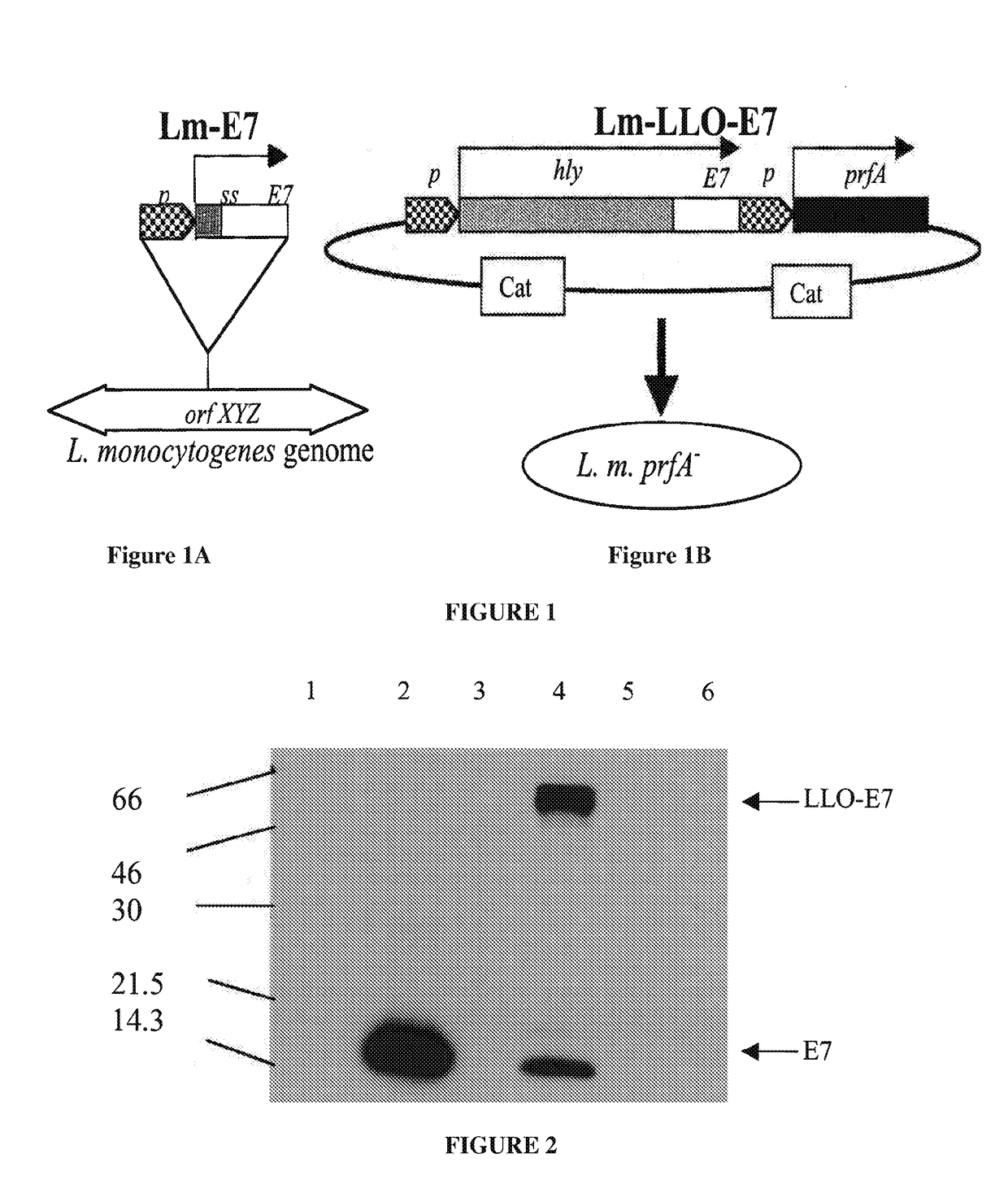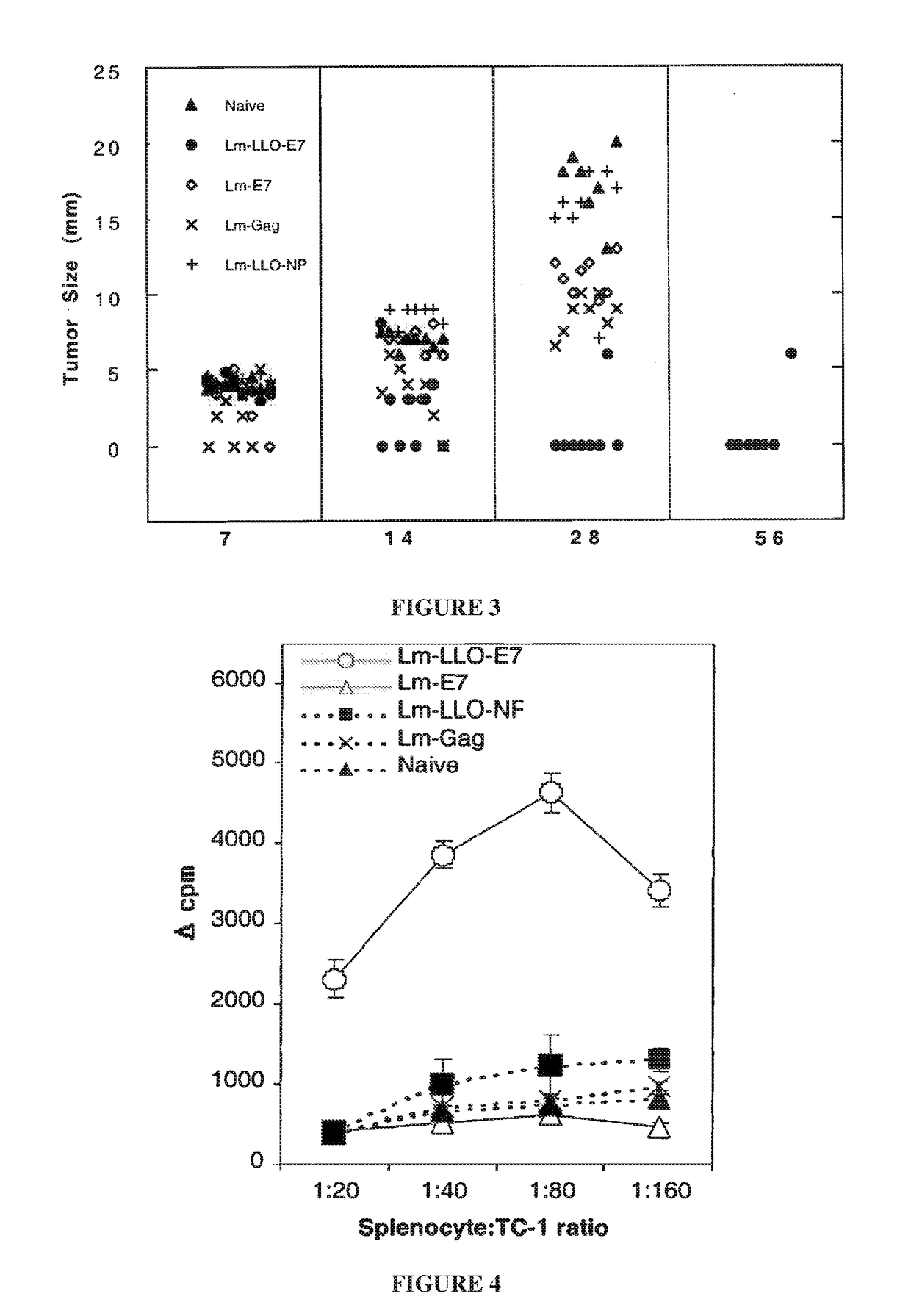Manufacturing device and process for personalized delivery vector-based immunotherapy
a manufacturing device and vector technology, applied in the direction of immunological disorders, antibody medical ingredients, packaged goods, etc., can solve the problems of insufficient immune response, treatment worked well for some patients and not so well for others, and the immune system destroyed early-stage cancerous cells
- Summary
- Abstract
- Description
- Claims
- Application Information
AI Technical Summary
Benefits of technology
Problems solved by technology
Method used
Image
Examples
example 1
en Fusions Induce Anti-Tumor Immunity
[0585]Results
[0586]Lm-E7 and Lm-LLO-E7 were compared for their abilities to impact on TC-1 growth. Subcutaneous tumors were established on the left flank of C57BL / 6 mice. Seven days later tumors had reached a palpable size (4-5 mm). Mice were vaccinated on days 7 and 14 with 0.1 LD50 Lm-E7, Lm-LLO-E7, or, as controls, Lm-Gag and Lm-LLO-NP. Lm-LLO-E7 induced complete regression of 75% of established TC-1 tumors, while tumor growth was controlled in the other 2 mice in the group (FIG. 3). By contrast, immunization with Lm-E7 and Lm-Gag did not induce tumor regression. This experiment was repeated multiple times, always with very similar results. In addition, similar results were achieved for Lm-LLO-E7 under different immunization protocols. In another experiment, a single immunization was able to cure mice of established 5 mm TC-1 tumors.
[0587]In other experiments, similar results were obtained with 2 other E7-expressing tumor cell lines: C3 and EL...
example 2
Treatment Elicits TC-1 Specific Splenocyte Proliferation
[0589]To measure induction of T cells by Lm-E7 with Lm-LLO-E7, TC-1-specific proliferative responses, a measure of antigen-specific immunocompetence, were measured in immunized mice. Splenocytes from Lm-LLO-E7-immunized mice proliferated when exposed to irradiated TC-1 cells as a source of E7, at splenocyte: TC-1 ratios of 20:1, 40:1, 80:1, and 160:1 (FIG. 4). Conversely, splenocytes from Lm-E7 and rLm control-immunized mice exhibited only background levels of proliferation.
example 3
nd PEST-E7 Fusions Confer Anti-Tumor Immunity
[0590]Materials and Methods
[0591]Construction of Lm-ActA-E7
[0592]Lm-ActA-E7 is a recombinant strain of LM, comprising a plasmid that expresses the E7 protein fused to a truncated version of the actA protein. Lm-actA-E7 was generated by introducing a plasmid vector pDD-1, constructed by modifying pDP-2028, into Listeria. pDD-1 comprises an expression cassette expressing a copy of the 310 bp hly promoter and the hly signal sequence (ss), which drives the expression and secretion of ActA-E7; 1170 bp of the actA gene that comprises four PEST sequences (SEQ ID NO: 19) (the truncated ActA polypeptide consists of the first 390 AA of the molecule, SEQ ID NO: 11); the 300 bp HPV E7 gene; the 1019 bp prfA gene (controls expression of the virulence genes); and the CAT gene (chloramphenicol resistance gene) for selection of transformed bacteria clones (Sewell et al. (2004), Arch. Otolaryngol. Head Neck Surg., 130: 92-97).
[0593]The hly promoter (pHly)...
PUM
| Property | Measurement | Unit |
|---|---|---|
| Pressure | aaaaa | aaaaa |
| Flow rate | aaaaa | aaaaa |
| Flow rate | aaaaa | aaaaa |
Abstract
Description
Claims
Application Information
 Login to View More
Login to View More - R&D
- Intellectual Property
- Life Sciences
- Materials
- Tech Scout
- Unparalleled Data Quality
- Higher Quality Content
- 60% Fewer Hallucinations
Browse by: Latest US Patents, China's latest patents, Technical Efficacy Thesaurus, Application Domain, Technology Topic, Popular Technical Reports.
© 2025 PatSnap. All rights reserved.Legal|Privacy policy|Modern Slavery Act Transparency Statement|Sitemap|About US| Contact US: help@patsnap.com



